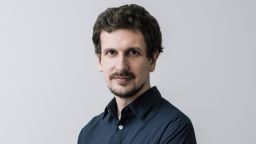Story highlights
30 years after Chernobyl, photographer Niels Ackermann shows us the disaster's real legacy
He reveals three years in the life of Yulia, who lives near the infamous Ukraine nuclear plant
Chernobyl.
Yep, most of us already know what happened exactly 30 years ago Tuesday, when that Ukranian power plant became synonymous with the worst nuclear disaster in history.
But award-winning Swiss photojournalist Niels Ackermann wants to show you a face of Chernobyl you’ve never seen.
Ackermann isn’t interested in making you sit through another telling of that tragic tale about the firefighters who couldn’t put out the flames in 1986, or the technicians who failed to stop the poisonous radioactive particles from escaping the facility and raining down on nearby residents.

Instead, he wants to introduce you to Yulia.
“She’s intense, like an energy bomb,” Ackermann said, describing the 23-year-old woman he met in 2012. At the time, Yulia was kissing a man in a park in the center of Slavutych, a town near Chernobyl built for disaster evacuees.
She told Ackermann he could take all the pictures he wanted if he promised not to show them to her mother.
Little did Ackermann know that three years later he’d still be following Yulia’s life.
“These essentially are the children of Chernobyl,” Ackermann said. “This town exists because of Chernobyl.”
“Chernobyl acts like a black hole, vacuuming all these young people there, whatever they did as students,” Ackermann said. “But that’s a totally rational choice and they mostly like what they’re doing.”
For now Slavutych’s future is limited by the future of Chernobyl, he said, because no other big industry has succeeded in developing near the city.
The legacy of Chernobyl — the young people of Slavutych — have reached a crossroads and Ackermann was there to photograph it.
From 2012 to April 2015, Ackermann watched Yulia turn into a young adult through his camera’s viewfinder. He saw her struggle as she moved from job to job and from a party lifestyle to relationships, marriage and then divorce.
Yulia was born three years after the disaster. Ackermann once asked her what she thought about its consequences. “She was looking at me like it was a really stupid questIon,” he recalled. “Because now, the scale of health consequences resulting from radioactivity in Slavutych are much more limited than what we may think about in the West.” Slavutych residents who work in Chernobyl are protected by strict control systems. The town’s attitude about radioactivity is much more realistic and pragmatic than it would be elsewhere. One young man showed Ackermann the tomb of his best friend in a cemetery and said more people in town die because of drugs and alcohol than radioactivity.
“She can be funny,” Ackermann said, “full of energy … she’s into dancing and singing and laughing. She’s a lively person. She’s very open to the world and curious about discovering other cultures.”
Now, Yulia works as a translator at the most important job site in the region: the New Safe Confinement arch that’s being built to permanently seal the remains of the burned nuclear reactor.
The project gives Yulia and other locals who work there good reasons to stay in the area. Most importantly, there is work — at least until the project is finished.
Completing the arch has become a sort of personal goal for them, said Ackermann.
“Yulia told me, ‘I want to see this arch finished. I want to see the result.’ For me there’s something very beautiful about this. They have this mission which they never asked for, which their parents left undone.”
If all goes as planned during the final phase of the project in 2017, the New Safe Confinement’s gigantic, 30-story-tall arch will slide over the ruined reactor and the site will be sealed forever.
This likely will be Chernobyl’s final chapter. And Yulia will help write it.
Then what? “To me, she is dreaming too much to stay in a small town like Slavutych,” Ackermann said. “She knows she will have to go to a broader horizon.”
Niels Ackermann is a Swiss photojournalist and founding member of the agency Lundi13. He lives in Kyiv, Ukraine. His book “L’Ange Blanc” (The White Angel) will be published by Les Editions Noir sur Blanc.



















